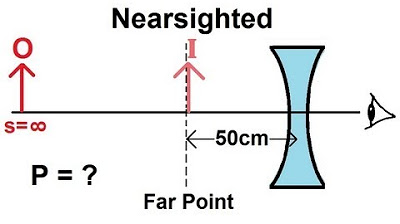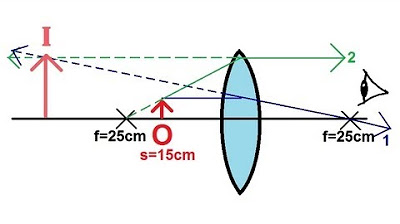Physics - Optics: Vision Correction (5 of 5) Very Farsighted
TLDRThis script explains the process of vision correction for farsighted individuals with a near point at 100 centimeters. It illustrates the use of reading glasses with converging lenses to bring the image into a clear focus. The lens equation is applied to calculate the required focal length of 33 centimeters, equating to +3 diopters. The summary emphasizes the practical solution of using glasses marked with +3 to correct vision and enable clear reading for those with a near point beyond the standard arm's length.
Takeaways
- 👓 The script discusses vision correction for farsightedness using reading glasses.
- 🎯 Farsighted individuals have a near point, which is the closest distance at which they can see objects clearly without correction.
- 📏 The near point mentioned in the example is 100 centimeters, which is more than the typical arm's length.
- 🤔 The challenge for a farsighted person is that they cannot hold a book close enough to read without assistance.
- 🔍 To correct this, the person needs reading glasses with converging lenses to bring the image closer to the eye.
- 📚 The script provides a practical example of reading a book at a distance of 25 centimeters.
- 🧐 The lens equation 1/F = 1/s + 1/s' is used to calculate the required focal length of the reading glasses.
- 🔢 Plugging in the numbers, the script calculates the focal length to be 33 centimeters for the reading glasses.
- 🔄 The power of the lens is determined by the reciprocal of the focal length in meters, resulting in +3 diopters.
- 🛍️ The script suggests that a person should find glasses marked with +3 diopters to correct their vision at the specified near point.
- 📝 The script concludes by summarizing the process of determining the strength of reading glasses needed for a farsighted person.
Q & A
What is the condition referred to as being farsighted?
-Being farsighted, or having hyperopia, is a condition where a person can see distant objects more clearly than nearby objects because the eye focuses images behind the retina.
What is the 'near point' mentioned in the script?
-The 'near point' is the closest distance at which a person can see an object clearly without any correction. In the script, it is mentioned as being 100 centimeters away for the farsighted person.
Why can't a farsighted person hold a book and read at the same time?
-A farsighted person cannot hold a book and read at the same time because their near point is beyond the length of their arm, making it impossible to focus on the text at a comfortable reading distance.
What is the purpose of reading glasses for farsighted individuals?
-Reading glasses with converging lenses help farsighted individuals to see nearby objects clearly by adjusting the focal point of the light to fall on the retina.
What is the formula used to calculate the focal length needed for reading glasses in this script?
-The lens equation used in the script is 1/F = 1/s + 1/s', where F is the focal length, s is the object distance, and s' is the image distance.
What is the object distance (s) used in the calculation for the reading glasses in the script?
-The object distance (s) used in the calculation is 25 centimeters, which is a typical comfortable reading distance for many people.
What is the image distance (s') for the reading glasses calculation in the script?
-The image distance (s') is given as -100 centimeters, which indicates that the image is formed 100 centimeters behind the lens, which is the near point for the farsighted person.
How is the focal length (F) calculated in the script?
-The focal length (F) is calculated by solving the lens equation for F, which results in F = 100/3 centimeters, or approximately 33.33 centimeters.
What is the power of the lens needed for the reading glasses, and how is it expressed?
-The power of the lens needed is +3 diopters, which is calculated as the reciprocal of the focal length in meters (1/0.33 m).
What does the term 'diopters' represent in the context of eyeglasses?
-Diopters is the unit of measurement for the strength of a lens used in eyeglasses, with a positive value indicating a converging lens suitable for farsighted individuals.
How can a farsighted person correct their vision to read clearly?
-A farsighted person can correct their vision to read clearly by wearing reading glasses with a power of +3 diopters, which will adjust the focal point to their near point of 100 centimeters.
Outlines
📚 Correcting Farsightedness Explained
This paragraph discusses the correction of farsightedness. It introduces a person with a near point of 100 centimeters, indicating that they cannot see anything clearly within that range. The paragraph explains the use of reading glasses with converging lenses to help focus images at a readable distance. Using the lens equation, the focal length needed for the reading glasses is calculated to be 33 centimeters, translating to a lens power of +3 diopters. The process involves combining distances to solve for the focal length and determining the appropriate strength of the glasses for clear reading.
Mindmap
Keywords
💡Farsighted
💡Near Point
💡Reading Glasses
💡Converging Lenses
💡Lens Equation
💡Focal Length
💡Power of a Lens
💡Diopters
💡Positive Lens
💡Binoculars
Highlights
Vision correction for farsighted individuals involves adjusting the near point to a more accessible distance.
A near point of 100 centimeters is described, which is over three feet away, making close-up tasks difficult.
The need for reading glasses with converging lenses is introduced to correct vision for those with a far near point.
The lens equation 1/F = 1/s + 1/s' is used to calculate the required focal length for reading glasses.
A practical example is given where the book is held at 25 centimeters, and the near point is 100 centimeters.
The image distance s' is negative, indicating the image is formed in front of the lens.
The solution for the focal length F is derived using the lens equation, resulting in 33 centimeters.
The power of the lens is calculated as +3 diopters, which is the strength needed for the reading glasses.
The unit 'diopters' is used to measure the strength of lenses, with a positive value indicating a converging lens.
The importance of selecting the correct lens power is emphasized for effective vision correction.
The transcript provides a step-by-step guide on how to calculate the necessary lens power for farsightedness.
A clear explanation of the mathematical process behind vision correction with reading glasses is given.
The transcript demonstrates the practical application of the lens equation in everyday vision correction.
The concept of a near point and its significance in vision correction for farsighted individuals is explained.
The transcript addresses the common issue of farsighted individuals being unable to read at a comfortable distance.
The solution to correct vision to a near point of 100 centimeters using +3 diopters lenses is presented.
The transcript concludes with instructions on how to find and use the correct reading glasses for vision correction.
Transcripts
Browse More Related Video

Physics - Optics: Vision Correction (4 of 5) Farsighted

Near Point and Far Point | Physics with Professor Matt Anderson | M28-06

Physics - Optics: Vision Correction (2 of 5) Nearsighted

Physics - Optics: Lenses (4 of 4) Converging Lens

Physics - Optics: Vision Correction (1 of 5) Introduction

Physics - Optics: Lenses (1 of 4) Converging Lens
5.0 / 5 (0 votes)
Thanks for rating: